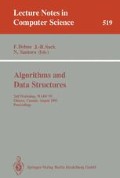Abstract
We present a randomized algorithm of expected time complexity O(m 2/3 n 2/3log4/3 m+mlog2 m+nlog2 n) for computing bi-chromatic farthest neighbors between n red points and m blue points in ɛ3. The algorithm can also be used to compute all farthest neighbors or external farthest neighbors of n points in ɛ3 in O(n 4/3log4/3 n) expected time. Using these procedures as building blocks, we can compute a Euclidean maximum spanning tree or a minimum-diameter two-partition of n points in ɛ3 in O(n 4/3log7/3 n) expected time. The previous best bound for these problems was O(n 3/2log1/2 n). Our algorithms can be extended to higher dimensions.
We also propose fast and simple approximation algorithms for these problems. These approximation algorithms produce solutions that approximate the true value with a relative accuracy ɛ and run in time O(nɛ(1−k)/2logn) or O(nɛ(1−k)/2log2 n) in k-dimensional space.
Preview
Unable to display preview. Download preview PDF.
References
P. Agarwal, H. Edelsbrunner, O. Schwarzkopf, and E. Welzl. Euclidean minimum spanning trees and bichromatic closest pairs. Proc. of 6th ACM Symp. on Computational Geometry, 1990, pp. 203–210.
F. Aurenhammer. Improved algorithms for discs and balls using power diagrams. Journal of Algorithms, 9 (1988), 151–161.
B. Chazelle. How to search in history. Information and Control, 64 (1985), 77–99.
K. Clarkson. Fast expected-time and approximate algorithms for geometric minimum spanning tree. Proc. 16th Annual Symposium on Theory of Computing, 1984, pp. 342–348.
K. Clarkson. A randomized algorithm for closest-point queries. SIAM J. Computing, 17 (1988), 830–847.
K. Clarkson and P. Shor. Applications of random sampling in computational geometry, II. Discrete and Computational Geometry. 4 (1989), pp. 387–421.
H. Edelsbrunner. An acyclicity theorem for cell complexes in d dimensions. Proc. of 5th ACM Symp. on Computational Geometry, 1989, pp. 145–151.
H. Edelsbrunner. Algorithms in Combinatorial Geometry, Springer-Verlag, 1987.
H. Edelsbrunner and R. Seidel. Voronoi diagrams and arrangements. Discrete and Computational Geometry, 1 (1985), 25–44.
H. Edelsbrunner and M. Sharir, A hyperplane incidence problem with applications to counting distances. Proc. of International Symposium on Algorithms, LNCS 450, Springer-Verlag, 1990.
O. Egecioglu and B. Kalantari. Approximating the diameter of a set of points in the Euclidean space. Technical report, Rutgers University, 1989.
H. N. Gabow and R. E. Tarjan. A linear-time algorithm for a special case of disjoint set union. Journal of Computer and System Sciences, 30 (1985), 209–221.
R. L. Graham and P. Hell. On the history of minimum spanning tree problem. Annals of History of Computing, 7 (1985), 43–57.
D. Haussler and E. Welzl. ∈-nets and simplex range queries, Discrete and Computational Geometry. 2 (1987), 127–151.
C. Monma, M. Paterson, S. Suri and F. F. Yao. Computing Euclidean maximum spanning trees. Algorithmica, 5 (1990), 407–419.
C. Monma and S. Suri. Partitioning points and graphs to minimize the maximum or the sum of diameters. Proceedings of 6th International Conference on the Theory and Applications of Graphs, John Wiley and Sons, 1989
F. P. Preparata and M. I. Shamos. Computational Geometry. Springer Verlag, New York, 1985.
F. Preparata and R. Tamassia. Efficient spatial point location. Workshop on Algorithms and Data Structures, LNCS 382, Springer-Verlag, (1989), 3–11.
R. Seidel. A convex hull algorithm optimal for point sets in even dimensions. University of British Columbia, Vancouver, 1981.
P. Vaidya. Minimum spanning trees in k-dimensional space. SIAM J. of Computing, 17 (1988), 572–582.
P. Vaidya. An O(n log n) algorithm for the all-nearest-neighbor problem. Discrete and Computational Geometry, 4 (1989), 101–115.
A. Yao. On constructing minimum spanning trees in k-dimensional spaces and related problems, SIAM J. Computing, 11 (1982), 721–736.
Author information
Authors and Affiliations
Editor information
Rights and permissions
Copyright information
© 1991 Springer-Verlag Berlin Heidelberg
About this paper
Cite this paper
Agarwal, P.K., Matoušek, J., Suri, S. (1991). Farthest neighbors, maximum spanning trees and related problems in higher dimensions. In: Dehne, F., Sack, JR., Santoro, N. (eds) Algorithms and Data Structures. WADS 1991. Lecture Notes in Computer Science, vol 519. Springer, Berlin, Heidelberg. https://doi.org/10.1007/BFb0028254
Download citation
DOI: https://doi.org/10.1007/BFb0028254
Published:
Publisher Name: Springer, Berlin, Heidelberg
Print ISBN: 978-3-540-54343-5
Online ISBN: 978-3-540-47566-8
eBook Packages: Springer Book Archive

